Tilcara
Tilcara is a pleasant town (pueblo) in Jujuy in Argentina. It is the tourist centre of the world heritage site Quebrada de Humahuaca, and in addition to having its own sights to see, it makes a good base for day trips to other towns in the area.


Understand
Tilcara is the major touristic centre of the Quebrada de Humahuaca and the archaeological centre of Argentina. It exhibits Spanish colonial architecture combined with local elements as well as Precolumbian archaeology. The population is mainly indigenous as is typical to northern Argentina, comprising of Kolla indians. The original language of the Kolla remains unknown (possibly Cacan). Later Inca occupation brought Quechua toponomy but otherwise Quechua did not hold as it did in other parts of the north. Nowadays the only language spoken is Spanish. Some interracial tensions exist between white settlers and the indigenous population but these do not hold for tourists who are warmly welcomed. The area is relatively poor compared with Buenos Aires and Patagonia. Nonetheless, it is much richer than nearby Bolivia which attracts many Bolivian immigrants to settle in the area.
Get in
On foot
You can hike between Pucarama and Tilcara, and see the hills at Maimará and the Cerro Paleta del Pintor a little further.
Get around
By foot.
See
- 🌍 Pucará. 09:00-18:00. The Omaguaca fortress atop the cliff. It is Tilcara's main attraction and what has made it known as the Argentinian capital of archaeology. The entry ticket allows you a visit to the local Archaeological Museum at the main town square as well as to the Botanic Garden of Heights adjacent to the Pucara and representing local vegetation of more than 2,500 m above sea level altitude including giant cordon cacti. AR$150/80 foreigners/locals (supposedly free entrance on Monday, otherwise check out the back of the mountain).
- Museo Irureta. A local art museum mainly representing the local art colony featuring the colourful landscape and the indigenous locals.
- Museo Atelier Terry. Terry was a famous Argentinian painter from Buenos Aires who chose Tilcara as the location of his atelier. Some of his paintings are on display.
- Indeginous Cemetery. The one in nearby Maimara enjoys more fame but the one Tilcara similarly exhibits the local tradition of dried flowers or more modern ones made of paper on each of the tombs.
- Food and textile market.
- Church. Built in the typical style, white painted adobe and adorned with a cordon cactus skeleton. The skeleton is strong enough to be used for building but the plant is protected nowadays.
- La Isla. Precolumbian cemetery 8 km north of Tilcara. It is one of many such Precolumbian archaeological sites scattered in the Quebrada. These were the main reason for its inscription as a world heritage site.
The town features further museums http://www.tilcarajujuy.com.ar/museos/museos.htm.
Do
- 🌍 Garganta del Diablo. Take a hike to this waterfall. 2-3 hr return. Get maps from the tourist office or use OpenStreetMap (with the OsmAnd or MapsMe mobile apps). AR$30 for taking the stairs. But if you continue about 100 m, a trail leads off the road and after 50 m steep down into the valley towards the waterfall. Bring proper shoes, there are cactuses that provide foothold, but are not convenient for flip-flops or Converse sneakers though—see maps.
- Rent a bike and explore the surrounding countryside. Bike rental shop located across the street from the tourist office. They're disorganized and have irregular opening hours, but are friendly people. AR$8 per hour, or AR$30 for the day.
Buy
Lots of interesting shops and friendly souls to guide. Most items are in indigenous Andean style pursuing a long tradition dating back to Pre-columbian times.
Money
The only bank in town (Macro) does only change money for clients. There are some unofficial exchange offices around the plaza, try Arte Andino, or ask at the tourist information just beyond the bridge after the entrance. Rates are usually about 10% off, especially since the pesos are very volatile.
Eat
Make sure you try out some of the local Andean specialities very different from normal Argentinian cuisine. Some typical dishes are quinoa, papas andinas, llama stew, empanadas jujenas, sweetened pumpkin, sopa de mani (peanut soup) and a spicy tomato spread. Several local restaurants specialize in Andean food. Some also feature live music shows of local music.
- La Pena is a little cafe on one corner of the square. They serve an excellent round tamale and rich, strong coffee in unique delicate, elegant cups with thin walls and a very pretty light brown coffee colored glaze. (They do not sell the cups.) The cafe also hosts music and poetry fests.
- The very touristy looking place on the corner as you pull into Tilcara, with a woman's name, has mediocre food, service and dining.
Drink
Sleep
- 🌍 Tierra Andina Hostel, Alvear 656, ☎ +54 388154196850, +54 1161937076, e-mail: tierraandina@hotmail.com. Not fancy and hip but one of the cheapest in town and central. Facebook:Tierra Andina Hostel. Dorm from Ar$150.
- La Mora Da Tilcara. Great little cabin style accommodation 200 metres from the bus terminal. Spotless and resembles a 4 star hotel but with hostel prices.
- Hotel de Turismo Belgrano 590, next to the tourist office. Government-run hotel located between the bus station and the central square. Good value. Cable TV, heaters, strong hot water, bidets, most rooms have balconies with views. WiFi, but only in the lobby areas, doesn't reach most rooms. Hearty buffet breakfast is better than most. Singles from 100 Pesos.
Go next
- Salinas Grandes de Jujuy - a large salt flat not to be confused with the much larger Salinas Grandes in the Pampas area of Argentina. It is located more than 3500 metre above sea level and the road leading there is as scenic as the salt flat itself. You can take a taxi from Tilcara for a day tour which does not cost much.
- Humahuaca - the local urban centre similar in style to Tilcara but much larger.
- Purmamarca and the Cerro de siete colores - the most celebrated natural attraction of the Quebrada.